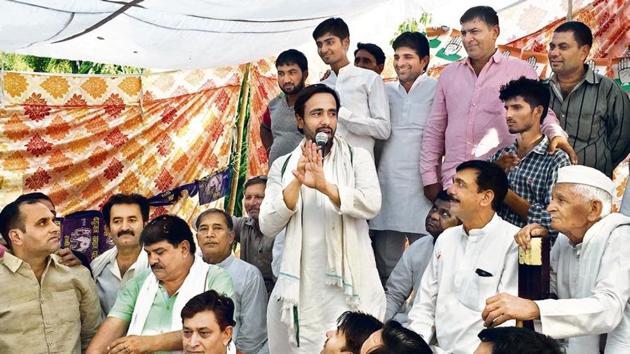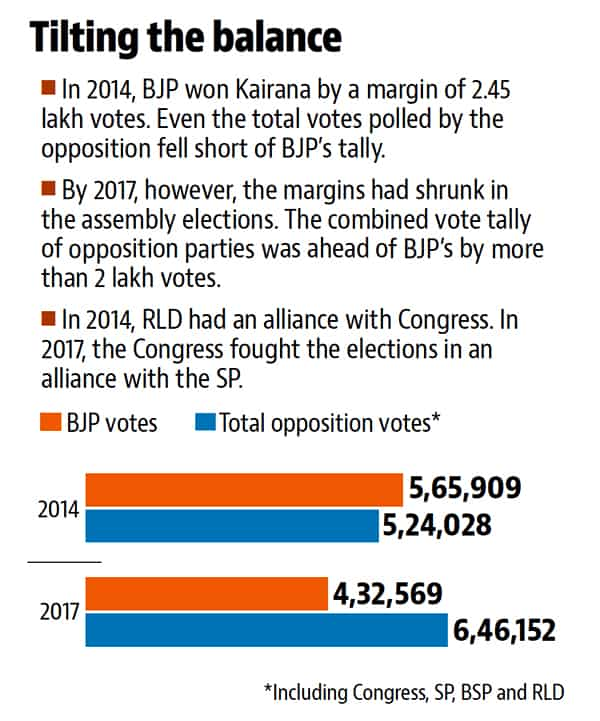Kairana bypoll: In battle of ‘honour’, yearning for social peace shapes political realignment
As the sugar bowl gets ready to vote on May 28, economic distress and growing clarity about the need for social harmony are shaping a new political alliance in Uttar Pradesh’s Kairana.
“All eyes are set on Kairana,” local MLA Tejendra Nirwal tells the crowd at a Bharatiya Janata Party (BJP) rally in a mostly upper-caste neighborhood of Shamli town. “Your vote will send out a message to the entire country. It will point to what might happen in 2019,” he said in the run up to Kairana bypoll

Barely 40 kilometers away, in Jat-dominated Bhainswal village, Rashtriya Lok Dal (RLD) leader Jayant Choudhury loudly declares to his supporters: “This is not a by-election. This is a big fight.”
Shamli lies at the heart of Kairana Lok Sabha constituency that votes Monday in a by-election necessitated by the death of its member of parliament (MP), Hukum Dev Singh of the BJP. In 2014, Singh won this seat in western Uttar Pradesh by a huge margin in a bitterly polarised contest following unprecedented communal riots in the region.
Four years on, the BJP is struggling to defend Kairana against a united opposition. Its candidate, Hukum Dev Singh’s daughter Mriganka, is up against the formidable Tabassum Hasan, who is contesting on an RLD ticket and has the support of the Samajwadi Party (SP), the Bahujan Samaj Party (BSP) and the Congress party as well.
The stakes have increased for the BJP in Kairana following the defeat of its candidates to those of the SP, supported by the BSP, in by-elections to the Lok Sabha from Gorakhpur and Phulpur in March.
The contest in Kairana is, doubtless, a crucial test of opposition unity. The tone and tenor of the campaign in the constituency also makes it a microcosm of the social issues and economic concerns that may potentially define the general elections of 2019.
Take, for instance, the decision to field Tabassum as the opposition candidate. The social arithmetic is compelling. Kairana has about 1.6 million voters, of which an estimated 960,000 (60%) make up the new social alliance the opposition has stitched up — 5,40,000 Muslims (33%), 2,80,000 Dalits (18%) and 1,40,000 Jats (9%), according to data available with political parties on both sides.
The BJP is leaning on upper caste groupings, that account for about 2,80,000 voters (18%) with other non-Jat backward castes adding up to 3,60,000 (22 %). The BJP also hopes to chip away at some of the Jat and Dalit votes — especially the non-Jatavs who lack an affinity for Mayawati’s BSP.
The opposition’s challenge is to keep its flock together while the BJP sees a chance only if it gets most of its core supporters to show up to vote. Simply put, Kairana is telling us that new social alliances are being forged. The equations of 2014 and 2017 might no longer hold.
Also read: How will a BSP-SP alliance shape up? Key LS bypoll in Kairana may hold the key
Towards a new unity
A split opposition and the unwavering support of the Jats helped the BJP score a spectacular sweep of western UP in the 2014 general elections that continued into the 2017 assembly polls as well. The BJP won four of Kairana’s five assembly seats.
But once the dust of the 2017 polls settled, the Jats seem to have suddenly found themselves confronting a new political reality they had perhaps not bargained for. The natural party of the Jats, so to speak, has for long been the RLD, which is now facing political extinction, having failed to even get either a single MP or an MLA elected.
“I will not say this is your last chance to resurrect your honour, but I will say that this is not the last time there will be attempts to undermine the Jat community,” Brahm Singh Baliyan, a local RLD leader, tells the voters of Bhainswal.
Complaints against the current regime resonate among the community. Jat leaders and village elders, in particular, are the most vocal. At election meetings, they allege that the government of Prime Minister Narendra Modi had told the Supreme Court in an affidavit that it cannot pay farmers one-and-a-half times the cost of their produce.
If that is not anti-farmer enough, they say, there is the Yogi Adityanath government in the state has almost doubled the cost of the electricity farmers use. No one, they bemoan, seems to be taking the Jat community seriously because it has lost its political clout.
“It is a fight to save the legacy of Chaudhury Charan Singh,” says RLD spokesman Sunil Rohta, referring to the late Jat leader who became India’s prime minister in 1979 for about six months. Rohta says the fear of becoming politically irrelevant is bringing the Jats back to the RLD’s fold.
The Jats would have loved to see one of theirs contest Kairana, but they are willing to rally behind an outsider because they want to save the party symbol, says another RLD leader. “They are voting for the handpump (RLD’s election sysmbol). It doesn’t matter who the candidate is.”

Tabassum Hasan was with the SP until a month ago and switched to the RLD after SP chief Akhilesh Yadav agreed to make RLD the contender for Kairana. Prior to joining the SP, she was elected MP from Kairana in 2009 on a BSP ticket.
BJP’s man in-charge of the elections in Kairana, Sanjeev Balyan, concedes that the Jats will mostly go with the RLD, which is why his strategy has been largely confined to mobilising voters from the upper caste and non-Jat other backward classes (OBCs) to turn up on the day of polling.
Thus far, Balyan has refrained from holding large rallies. Instead, he has been holding street corner meetings, at which he often highlights an improvement in the law and order situation, the government’s efforts to build roads, schools and hospitals and the danger of all these efforts being derailed if the opposition candidate wins.
Back in Shamli, Nirwal is articulating a similar message. “On May 28, you shall leave everything aside, come out in the open and cast your vote in support of PM Modi,” he tells the crowd. “If you stay home, it will not be one vote short for us, it will be one vote plus for the opposition. And if they win, everything you have dreaded will return to haunt you.”
But the politics of fear is not the only factor influencing the voters of Kairana. The failure of sugar mills in the region to make timely payments for cane procurement and the lack of intervention by the state government has angered farmers.
Ganna, Jinnah and Rana
Sugarcane is Kairana’s economic lifeline. The region produces more than 5 million tonnes of the crop annually. Farmers sell their produce entirely to the six mills that operate in Kairana. Mills procure sugarcane at a range of rates fixed by the government. Mill owners often tend to delay payments to farmers, especially when the market for sugar is down.
This year happens to be one of those bad years; sugar prices have slumped nearly 25%. But the fallout on farmers has been more devastating.
Across Uttar Pradesh, as of last week, farmers had not received more than a third of the ₹33,376 crore that was due for payment from mill owners. It is even worse in Kairana, where farmers have yet to receive an estimated ₹ 890 crore, or 52% of the ₹1,700-crore that was due to them.
“We have never seen a crisis like this. It has come to this because the government cares more for the mill owners than the farmers,” says Ajay Kumar, a former MLA. “In this election, they will pay a price for it.”
The irony is that the minister in charge of the sugarcane crop, Suresh Rana, belongs to Kairana. He was elected from the Thana Bhawan assembly segment. Rana told Hindustan Times that the payment crisis will have no impact on the vote of May 28.
Few can agree with him, not even his own party colleagues. “If this problem was not there, we would have won even without campaigning,” says Balyan.
Sugarcane growers are not the only ones taking the hit.
“The economy of this region revolves around sugarcane. When farmers don’t get money on time, they defer their spending. The local traders have seen a slump in business. There is a cascading impact,” said Ashok Choudhury, a local leader of the Samajwadi Party.
The delays in payment extend up to 4-5 months in many cases, despite a new 14-day deadline set by the BJP government in the state. The anger amongst the farmers is palpable. The opposition is losing no opportunity to cash in on the mood.
The latest in the string of barbs against the BJP is to mock the ruling party for obsessing over the founder of Pakistan Mohammad Ali Jinnah’s portrait in Aligarh Muslim University.
At the Bhainswal rally, Jayant Choudhury asks the audience: “What do you care for? Ganna or Jinnah?” The crowd responds: “Ganna! Ganna!” Some in the back rows add: “We also don’t want Rana,” a reference to the minister in charge of sugarcane.
Also read: Inside the riot machine
The bigger message
While the social churn ahead of the elections may have been in part driven by the sugarcane crisis and farmer distress, a wholly unexpected set of interventions are also assuming shape as Kairana readies for the poll.
The riots of 2013, as is now well documented, not only drew a sharp line between the two major communities, what is less understood is that the violence and murders also unraveled an otherwise tightly interdependent ecosystem of the villages in Kairana.
An overwhelming number of Muslims who fled their villages after the riots have chosen not to return. And many of them still do not want to. The blacksmith who fixed the Jat farmer’s equipment was often a local Muslim; the carpenter who made furniture was a Muslim, the mason who the village needed for house repairs was often a Muslim. In villages that have been deserted by Muslims, these services have now become expensive, and in some cases inaccessible. Jat farmers are feeling the absence of the Muslims economically the most, if not socially.
Muslim labourers, on the other hand, rue the fact that they could no longer easily borrow cash from their Jat employers or the local Bania trader. They, more than ever dread, now dread falling short of cash.
Talk of reconciliation and burying the bitter memories of the past is fairly loud and consistent. “We are ready to live together,” says Rajinder Malik, whose father heads the Gathwal Khap that allegedly incited the riots.
Malik’s village, Lishad, was one of the worst hit. All but one of its 250-odd Muslim families fled the village after 13 of their members died in the violence. As many as 102 first information reports (FIRs) were filed, involving 600-650 residents of Lishad.
Although Malik maintains that the Muslims are to be blamed for the riots, he has worked to clear a third of these cases through mutual settlement. He hopes the 22 cases that are still pending in courts would be resolved soon.
The surprisingly strong yearning for social peace in many villages that Hindustan Times visited suggests that polarisation is probably not sustainable in rural India, where economic interdependence requires social harmony.
In a nutshell, the election in Kairana tells us that issues of economic distress and growing clarity about the need for social harmony are indicating a possible social realignment on the ground in time for the 2019 election. The mood is very different from 2014.






